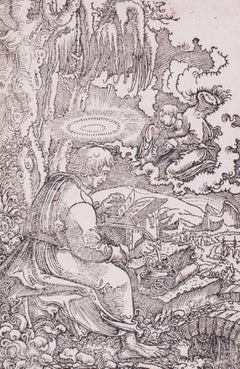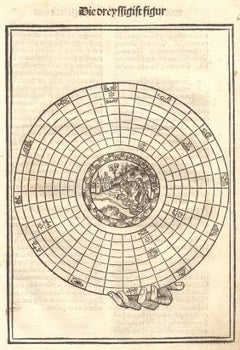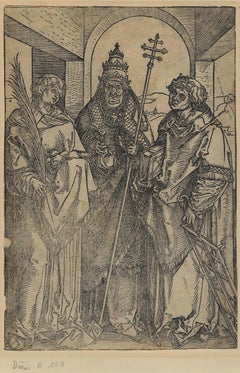Georg Lemberger Art
to
1
1
1
Overall Height
to
Overall Width
to
1
1
1
1
1
1
1
1
6,958
3,340
2,513
1,213
1
Artist: Georg Lemberger
Matthew the Evangelist
By Georg Lemberger
Located in Petworth, West Sussex
Georg Lemberger (German, c. 1490 – 1540)
Matthew the Evangelist
Woodcut on paper
5.3/4 x 3.3/4in. (14.5 x 9.6 cm. )
Hollstein, 7. This is from the New German bible...
Category
16th Century Old Masters Georg Lemberger Art
Materials
Woodcut
Related Items
Father Stefan Fridolin, "Schatzbehalter" (Treasury of the True Riches
Located in Fairlawn, OH
Father Stefan Fridolin, "Schatzbehalter" (Treasury of the True Riches of Salvation): The 30th Figure - Astrological Diagram with Scene of the Nativity
Woodcut, 1491
Unsigned, as issued
Published by Anton Koberger
Diagram has Zodiac signs on outer ring, planets in the lower registers, and Nativity in the center.
Condition: Very good for a 15h century woodcut, with the usual slight age stains
Sheet size: 11 1/2 x 8 1/4 inches
Wogelmut was the teacher of Albrecht Durer and employed young Durer in many project of the last decade of the 15th century.
Michel Wolgemut Biography
Wolgemut trained with his father Valentin Wolgemut (who died in 1469 or 1470) and is thought to have been an assistant to Hans Pleydenwurff in Nuremberg. He worked with Gabriel Malesskircher in Munich early in 1471, leaving the city after unsuccessfully suing Malesskircher's daughter for breach of contract, claiming she had broken off their engagement. He then returned to his late father's workshop in Nuremberg, which his mother had maintained since Valentin's death.
In 1472 he married Pleydenwurff's widow and took over his workshop;[3] her son Wilhelm Pleydenwurff worked as an assistant, and from 1491 a partner, to Wolgemut. Some consider Wilhelm a finer artist than Wolgemut, however he died in January 1494, when he was probably still in his thirties. Wilhelm's oeuvre remains unclear, though works in various media have been attributed to him.
Woodcuts
Michael Wolgemut, Danse Macabre, 1493
Two large and copiously illustrated books have woodcuts supplied by Wolgemut and his stepson Wilhelm Pleydenwurff; both were printed and published by Germany's largest publisher, the Nuremberger Anton Koberger, who was also Dürer's godfather. The first is the Schatzbehalter der wahren Reichthumer des Heils (1491); the other is the Historia mundi, by Schedel (1493), usually known as the Nuremberg Chronicle...
Category
15th Century and Earlier Old Masters Georg Lemberger Art
Materials
Woodcut
Saints Stephen, Sixtus, and Laurentius
By Albrecht Dürer
Located in Middletown, NY
circa 1504
Woodcut on cream laid paper, 8 1/2 x 5 7/8 inches (215 x 148 mm), thread margins. Significant expert repairs to lower right sheet edge, and center right sheet edge. Mino...
Category
16th Century Old Masters Georg Lemberger Art
Materials
Laid Paper, Woodcut
The Golden Calf - Nuremberg Chronicle, (528 Years Old)
Located in Santa Monica, CA
NUREMBERG CHRONICLE, 1493
THE GOLDEN CALF (THE CALF OF GOD) 1493
Woodcut. from "Liber Chronicarum." Printed by Anton Koberger text by Hartmann Sc...
Category
15th Century and Earlier Old Masters Georg Lemberger Art
Materials
Woodcut
BATHOS / Tail PIece
By William Hogarth
Located in Santa Monica, CA
WILLIAM HOGRATH (1767- 1764)
THE BATHOS / Tail Piece 1764 (Paulson 1989: 216 I/I Paulson 1965/70: 216 I/I)
Engraving Plate 12 7/8 x 13 3/8, sheet 17 ¾ x 18 ¾ Designed & Engrav’d by Wm Hogarth at left and Published according to Act of Parliam’t March 3, 1764 at right. Good condition on thick laid paper Small bit of tape on the left & right sheet edges small stan lower sheet edge all on recto.
This Hogarth’s last print is fascinating as it is prophacy about death.
Various institutions have interesting commentaries - to wit:
Chicago Art Institute: Hogarth created The Bathos toward the end of his life. It is considered one of the bleakest artworks of the 18th century because it depicts the Apocalypse without an afterlife. The Angel of Death even collapses in exhaustion after having destroyed the world. In his hand is an execution decree and around him lies a mass of broken objects.
Princeton: Hogarth’s last print, The Bathos,….. is filled with all manner of images denoting the end of life as we know it. Entry no. 216 in Ronald Paulson’s catalogue raisonne Hogarth’s Graphic Works, 3rd revised edition says “This print is the culmination of such pessimistic images . . . . [taking] his general composition, the configuration of objects, and some of the particular items, from Dürer’s engraving, Melancholia; but he also recalls Salvator Rosa’s Democritus in Meditation (which derives from Dürer’s print) with a scroll at the bottom of the etching: ‘Democritus the mocker of all things, confounded by the ending of All Things’ (Antal, p.168).”
Newfields (Indianapolis Museum of Art): Hogarth intended this engraving to serve as the tailpiece to bound volumes of his collected engravings and, appropriately, it proved to be his last engraving. Father Time has died and his last will and testament has been witnessed by the three Fates. He is surrounded by a landscape of death, decay, and ruin. Hogarth aimed this print at dealers in “dark” Old Masters paintings who promoted the idea that ruins evoked sublime feelings in viewers—a sentiment, Hogarth wrote, that was reducing the world to ruin.
British Caricature...
Category
1760s Old Masters Georg Lemberger Art
Materials
Woodcut
Animal Figures for Antiquities - Original Etching - Mid-18th Century
Located in Roma, IT
Animal Figures for the Antiquities of Herculaneum Exposed, original etching from the mid-18th century, made by Various Old Masters.
In very good condition, except for some stains al...
Category
18th Century Old Masters Georg Lemberger Art
Materials
Etching
H 4.06 in W 5.04 in D 0.08 in
Der Weisskunig - Woodcut Prints by Various artists - 1775
Located in Roma, IT
Der Weisskunig is an ancient set of Woodcuts realized in 1775, There are 14 plates from the Weisskunig series, the fictitious biography of Emperor Maximilian I...
Category
18th Century Old Masters Georg Lemberger Art
Materials
Woodcut
La Messe (The Mass), after Caravaggio
Located in Middletown, NY
Chiaroscuro woodcut with underlying engraving on cream laid paper, printed from two blocks in brown and olive. 10 1/4 x 12 3/4 inches (260 x 321 mm) (plate), full margins with the text printing clearly below in black ink. In very good condition with scattered surface soiling and several minor flecks of light discoloration in the margins, especially in the area of the lower right corner, well outside of image area. Unobtrusive notations in pencil in the margin and on the verso. All condition issues are consistent with age. After a drawing of the same title by Polidoro da Caravaggio...
Category
Mid-18th Century Old Masters Georg Lemberger Art
Materials
Engraving, Laid Paper, Woodcut
One Can't Tell Why - Proof from the Disasters of War
By Francisco Goya
Located in New York, NY
Francisco José de Goya y Lucientes (1746 Fuendetodos – Bordeaux 1828), No se puede saber por qué – One can’t tell why ca. 1808–1814, etching, burnished aquatint, drypoint, an...
Category
1810s Old Masters Georg Lemberger Art
Materials
Drypoint, Etching, Aquatint
Two military studies, a preparatory red chalk drawing by Jean-Baptiste Pater
By Jean-Baptiste Pater
Located in PARIS, FR
As Florence Ingersoll-Smouse wrote in 1921 in her book devoted to Jean-Baptiste Pater, "a painter of the Fête galante, Pater is interesting both by his intimacy with Watteau, to whom many of his works are still attributed, and by his own value as an artist.” This sanguine, full of life and spontaneity, is typical of the preparatory studies made by the painter to be used later in the composition of his paintings.
1. Jean-Baptiste Pater, pupil and disciple of Antoine Watteau
Antoine Pater, Jean-Baptiste's father, belonged to the petty bourgeoisie of Valenciennes where he worked as a merchant-sculptor. His brother Jacques was a local painter who was probably involved in his nephew's training. Born on December 29, 1695, Jean-Baptiste Pater was first trained with Jean-Baptiste Guider, a local painter whose death in 1711 was probably the reason for Jean-Baptiste’s departure alongside Watteau, who was visiting Valenciennes. Watteau's difficult character led to their separation in 1713.
Back in Valenciennes, Jean-Baptiste Pater encountered difficulties with the powerful Corporation of Saint-Luke (to which he refused to belong) which forced him to return to Paris in 1718. He reconciled with Watteau shortly before his death (on July 18th 1721), inherited the commissions that Watteau had been unable to fulfil and completed some of his paintings.
Pater was accepted by the Académie Royale in 1725 but did not produce his reception painting The soldier’s revels until three years later. Throughout his brief career (he died at the age of forty on July 25th 1736), he mainly had a clientele of amateurs and received only one royal commission, shortly before his death.
2. Description of the drawing and related artworks
Pater had adopted his master Watteau's method of composition. His study drawings were carefully glued in a notebook and were used to animate his compositions.
His paintings sometimes suffer from a somewhat artificial composition, since the figures seem to be pasted one next to the other. This point has also been made about Watteau’s.
The theme of military scenes (which was at the time included in the genre of Fêtes galantes!) was one of Pater’s favourite subjects. Together with the Bathing Women...
Category
1720s Old Masters Georg Lemberger Art
Materials
Chalk
Ancient Roman Relief - Original Etching - 18th Century
Located in Roma, IT
Ancient Roman Relief, from the series "Antiquities of Herculaneum", is an original etching on paper realized by an anonymous Artista in the 18th century.
...
Category
Late 18th Century Old Masters Georg Lemberger Art
Materials
Etching
H 4.14 in W 3.55 in D 0.08 in
Ancient Roman Fresco Herculaneum - Etching by Carlo Oratij - 18th Century
Located in Roma, IT
Ancient Roman Fresco from the series "Antiquities of Herculaneum", is an etching on paper realized by Carlo Oratij in the 18th Century.
Signed on the plate.
Good conditions.
The e...
Category
Late 18th Century Old Masters Georg Lemberger Art
Materials
Etching
H 4.73 in W 9.06 in D 0.08 in
Rônin in the Night, Armed with a Club - Woodcut by Utagawa Kunisada-19th Century
By Utagawa Kunisada III
Located in Roma, IT
This magnificent woodcut print signed Toyokuni III represents a Ronin in the night, armed with a club, and was realized by Utagawa Kunisada (1786-1865) in the mid 19th Century.
The ...
Category
19th Century Old Masters Georg Lemberger Art
Materials
Woodcut
H 14.14 in W 9.61 in D 0.01 in
Georg Lemberger art for sale on 1stDibs.
Find a wide variety of authentic Georg Lemberger art available for sale on 1stDibs. You can also browse by medium to find art by Georg Lemberger in woodcut print and more. Much of the original work by this artist or collective was created during the 18th century and earlier and is mostly associated with the Old Masters style. Not every interior allows for large Georg Lemberger art, so small editions measuring 4 inches across are available. Customers who are interested in this artist might also find the work of Albrecht Dürer, Johann Baptist Homann, and Frans Hogenberg. Georg Lemberger art prices can differ depending upon medium, time period and other attributes. On 1stDibs, the price for these items starts at $1,551 and tops out at $1,551, while the average work can sell for $1,551.
Artists Similar to Georg Lemberger
Carle Vernet (Antoine Charles Horace Vernet)


